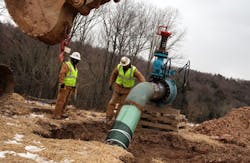High rate of fluid injection more likely to cause earthquakes
When oil and gas wastewater is injected underground at a faster rate, it seems to cause more earthquakes.
That's according to a new study from the University of Colorado Boulder and the U.S. Geological Survey.
Fluid is injected underground for enhanced oil recovery and to dispose of salty fluids generated during oil and gas production.
Researchers found that fluid injection wells used in oil and gas development are responsible for the dramatic increase in earthquakes in the central and eastern United States since 2009. And high-rate injection wells (those pumping more than 300,000 barrels of wastewater a month into the ground) are much more likely to be associated with earthquakes than lower-rate wells.
In addition to looking at injection rates of individual wells, the team also looked at other aspects of well operations including the cumulative injected volume of fluid over time, monthly injection pressure at individual wellheads, injection depth, and a well's proximity to basement rock where earthquake faults may lie. None of these factors showed significant correlation to seismic activity at a national level.
The research team noted that thousands of injection wells have operated across the study region over the last few decades without a ramp-up in seismic events. "It's really the wells that have been operating for a relatively short period of time and injecting fluids at high rates that are strongly associated with earthquakes," commented lead author Matthew Weingarten.
"People can't control the geology of a region or the scale of seismic stress," Weingarten continued. "But managing rates of fluid injection may help decrease the likelihood of induced earthquakes in the future."
The findings of the study have been published in the journal Science.
